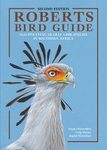Flora / Fauna Monograph
By: Rob Little(Author), Rutledge Boyes(Foreword By)
340 pages, colour photos, colour distribution maps
The definitive monograph on the gamebirds of Africa, this book offers a concise and updated summary of the large but scattered body of accumulated scientific research and field-guide literature.
![Gamebirds of Africa Gamebirds of Africa]()
Click to have a closer look
About this book
Customer reviews
Biography
Related titles
About this book
This is the definitive monograph on the gamebirds of Africa. This detailed full-colour handbook includes everything needed to identify and get to know the 89 species that fall into six groups: guineafowls and Congo Peafowl (7 species) francolins and partridges (33 species), spurfowls (26 species), quails (3 species), sandgrouse (13 species) and snipes and Eurasian Woodcock (7 species).
Gamebirds of Africa offers a concise and updated summary of the large but scattered body of accumulated scientific research and field-guide literature. Pertinent and interesting facts about the distribution, habits, breeding, and conservation status of each species are presented in a readable fashion. Numerous photographs convey the appearance, characteristic features, behavioural activities and, in many cases, the habitats frequented by each bird.
Gamebirds of Africa will be a worthy addition to the ornithological literature and to the bookshelves of bird enthusiasts, particularly birders, wing-shooters, land owners and anyone with an interest in nature and conservation, throughout Africa and across the rest of the world.
The publication of this book was made possible through the generous funding of the Wild Bird Trust and the FitzPatrick Institute of African Ornithology, University of Cape Town.
Customer Reviews
Biography
Rob Little attained a PhD on the behavioural ecology, management and utilisation of the Grey-winged Francolin from the University of Cape Town. Before that, he was a forester and warden of the Cathedral Peak mountain catchment reserve in the KwaZulu-Natal Drakensberg.
Between 1988 and 1997, Rob coordinated the Gamebird Research Programme at the FitzPatrick Institute of African Ornithology, UCT. Rob was the conservation director at WWF South Africa between 1997 and 2008, and played a significant role in the establishment and expansion of the Namaqua, Table Mountain and Tankwa national parks.
In 2009 he was appointed manager of the DST-NRF Centre of Excellence at the Fitztitute, where he manages the research activities that use Birds as Keys to Biodiversity Conservation.
Flora / Fauna Monograph
By: Rob Little(Author), Rutledge Boyes(Foreword By)
340 pages, colour photos, colour distribution maps
The definitive monograph on the gamebirds of Africa, this book offers a concise and updated summary of the large but scattered body of accumulated scientific research and field-guide literature.






































